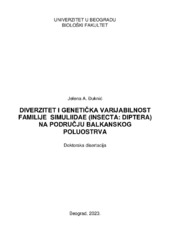Приказ основних података о документу
Diverzitet i genetička varijabilnost familije Simuliidae (Insecta: Diptera) na području Balkanskog poluostrva
Diversity and genetic variability of the Simuliidae family (Insecta: Diptera) in the area of the Balkan Peninsula
| dc.contributor | Živić, Ivan | |
| dc.contributor | Popović, Nataša | |
| dc.creator | Đuknić, Jelena | |
| dc.date.accessioned | 2023-05-24T10:17:07Z | |
| dc.date.available | 2023-05-24T10:17:07Z | |
| dc.date.issued | 2023 | |
| dc.identifier.uri | http://radar.ibiss.bg.ac.rs/handle/123456789/5671 | |
| dc.description.abstract | During period from 2013 to 2021 from 256 localities at the Balkan Peninsula, 46 simulids taxa (larvae and pupae) were identified. The dominant species was Simulium ornatum, followed by S. reptans, S. variegatum and S. balcanicum. Presence of Simulium turgaicum in the Balkan Peninsula was recorded for the first time. Most of the recorded species were euryvalent with respect to elevation and water body type. Prosimulium hirtipes was characteristic for small rivers, while S. brevidens was a crenobiont found at elevations above 800 m. The greatest diversity of simulids was found in small and medium water bodies at elevations of 500-800 m. High beta diversity characterized all studied groups of simulid communities. Genetic analyses (mtCOI gene) of the subgenus Wilhelmia, whereby it was represented by 7 species, revealed the presence of 15 monophyletic clades (potential species). Within the subgenus Wilhelmia, two monophyletic branches can be distinguished: the equinum branch consists of the morphospecies S. equinum and S. pseudequinum, while the lineatum branch consists of S. sergenti, S. paraequinum, S. lineatum, S. turgaicum, and S. balcanicum. Within morphospecies S. pseudequinum clades diversification occurred in the Oligocene, most likely by allopatric speciation. We assume that the clade S. pseudequinum B is endemic to the Balkan Peninsula. Within the lineatum line, the sister species S. lineatum, S. turgaicum, and S. balcanicum were represented by two clades each. Phylogenetic analyzes of the species S. reptans and S. reptantoides revealed the presence of two forms (A and B) in each of them. The distribution of S. reptans A is restricted to western and northern Europe, while S. reptans B has been found in the Balkans. Both forms of S. reptantoides occur in the Balkans, which could also be the place of origin of the form A. | en |
| dc.description.abstract | Na području Balkanskog poluostrva, u periodu od 2013-2021. godine identifikovano je 46 taksona simulida (larvi i lutaka) sa 256 lokaliteta. Dominantna vrsta bila je Simulium ornatum, a pratile su je S. reptans, S. variegatum i S. balcanicum. Vrsta S. turgaicum je prvi put zabeležena na Balkanskom poluostvu. Većina zabeleženih vrsta se pokazala eurivalentna u odnosu na nadmorsku visinu i tip vodotoka. Prosimulium hirtipes je karaktrističen za male, brze vodotokove, dok je S. brevidens je krenobiont vezan za nadmorske visine preko 800 m. Najveći diverzitet simulida zabeležen je u malim i srednjim vodotocima na nadmorskim visinama 500–800 m. Sve ispitivane grupe zajednica simulida karakterisao je visok beta diverzitet. Genetičkim analizama (mtCOI gena) podroda Wilhelmia, koji je bio predstavljen sa 7 vrsta, otkriveno je prisustvo 15 monofiletskih klada (potencijalnih vrsta). U okviru podroda Wilhelmia izdvojene su dve monofiletske grane: equinum granu čine morfo-vrste S. equinum i S. pseudequinum, dok lineatum granu čine S. sergenti, S. paraequinum, S. lineatum, S. turgaicum i S. balcanicum. Razdvajanje klada morfo-vrste S. pseudequinum desilo se u oligocenu, najverovatnije alopatričkom specijacijom. Pretpostavljamo da je klada S. pseudequinum B endemit Balkanskog poluostrva. U okviru lineatum linije, sestrinske vrste S. lineatum, S. turgaicum i S. balcanicum bile su prisutne sa po dve klade. Filogenetske analize vrsta S. reptans i S. reptantoides pokazale su prisustvo dve forme (A i B) kod svake od njih. Distribucija S. reptans A ograničena je na zapadnu i severnu Evropu, dok je S. reptans B zabeležen na Balkanu. Obe forme S. reptantoides prisutne su na Balkanu, koji ujedno može da predstavlja i mesto porekla A forme. | sr |
| dc.language.iso | sr | sr |
| dc.publisher | Belgrade: University of Belgrade, Faculty of Biology | sr |
| dc.rights | openAccess | sr |
| dc.rights.uri | https://creativecommons.org/licenses/by-nc-sa/4.0/ | |
| dc.source | Belgrade: University of Belgrade, Faculty of Biology | sr |
| dc.subject | Simuliidae | |
| dc.subject | Balkansko poluostrvo | sr |
| dc.subject | diverzitet | sr |
| dc.subject | genetička varijabilnost | sr |
| dc.subject | filogenija | sr |
| dc.subject | COI | |
| dc.subject | Wilhelmia | |
| dc.subject | Simulium reptans | |
| dc.subject | Simulium reptantoides | |
| dc.subject | Balkan Peninsula | en |
| dc.subject | diversity | en |
| dc.subject | genetic variability | en |
| dc.subject | phylogeny | en |
| dc.title | Diverzitet i genetička varijabilnost familije Simuliidae (Insecta: Diptera) na području Balkanskog poluostrva | sr |
| dc.title | Diversity and genetic variability of the Simuliidae family (Insecta: Diptera) in the area of the Balkan Peninsula | en |
| dc.type | doctoralThesis | sr |
| dc.rights.license | BY-NC-SA | sr |
| dc.rights.holder | © 2023 by the author. | sr |
| dc.citation.vancouver | Đuknić J. Diversity and genetic variability of the Simuliidae family (Insecta: Diptera) in the area of the Balkan Peninsula [dissertation]. Belgrade: University of Belgrade, Faculty of Biology; 2023. 96 p. | |
| dc.citation.spage | 1 | |
| dc.citation.epage | 96 | |
| dc.type.version | publishedVersion | sr |
| dc.identifier.fulltext | https://radar.ibiss.bg.ac.rs/bitstream/id/13209/Jelena_Djuknic.pdf | |
| dc.identifier.rcub | https://hdl.handle.net/21.15107/rcub_ibiss_5671 |

